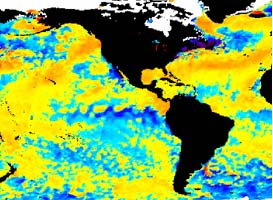| NOAA Magazine || NOAA Home Page |
NOAA NATIONAL WEATHER SERVICE SAYS LA NIÑA CONDITIONS CONTINUE TO DEVELOP
 June
13, 2003 � La
Niña conditions, marked by colder ocean temperatures in the
tropical Pacific, continued to develop for the second straight month,
report scientists at the NOAA
Climate Prediction Center in Camp Springs, Md. (Click NOAA
satellite image for larger view of latest La Niña conditions
taken June 10, 2003. Cooler sea surface temperatures are represented
in blue off the coast of South America. Please credit “NOAA.”)
June
13, 2003 � La
Niña conditions, marked by colder ocean temperatures in the
tropical Pacific, continued to develop for the second straight month,
report scientists at the NOAA
Climate Prediction Center in Camp Springs, Md. (Click NOAA
satellite image for larger view of latest La Niña conditions
taken June 10, 2003. Cooler sea surface temperatures are represented
in blue off the coast of South America. Please credit “NOAA.”)
In this month’s El Niño/Southern Oscillation (ENSO) Diagnostic Discussion, NOAA scientists report oceanic and atmospheric conditions in the tropical Pacific during May were consistent with a developing “cold episode,” or La Niña. By mid-May, subsurface temperatures ranged from 2 degrees Fahrenheit (1 degree C) to 8 degrees Fahrenheit (4 degrees C) colder than normal. These observed trends in oceanic and atmospheric variables indicate a transition from last year’s El Niño is underway, and La Niña conditions are likely to develop over the next few months.
“Current conditions and recent trends favor the development of cold episode [La Niña] conditions in the tropical Pacific during the next few months,” said Vernon Kousky, lead El Niño and La Niña scientist at the NOAA Climate Prediction Center. If La Niña develops as expected, it would likely bring increased Atlantic hurricane and tropical storm activity this year. Also, La Niña conditions would likely bring drier and warmer-than-average conditions to the southern United States next winter. Scientists at NOAA will continue to monitor this evolving situation closely.
The NOAA Climate Prediction Center defines La Niña as the periodic cooling of ocean surface temperatures in the central and east-central equatorial Pacific occurring on average every three to five years or so. La Niña represents the cool phase of the El Niño/Southern Oscillation (ENSO) cycle, and is sometimes referred to as a Pacific cold episode.
The ENSO Diagnostic Discussion is published monthly by the NOAA Climate Prediction Center and is a consolidated effort of NOAA and its funded institutions. The NOAA Climate Prediction Center is one of the National Centers for Environmental Prediction, which is part of the NOAA National Weather Service. The NOAA Climate Prediction Center predicts and monitors El Niño/La Niña and also produces the nation’s official long-range outlooks and medium-range weather forecasts.
NOAA is dedicated to enhancing economic security and national safety through the prediction and research of weather and climate-related events and providing environmental stewardship of the nation�s coastal and marine resources. NOAA is part of the U.S. Department of Commerce.
Relevant Web Sites
NOAA
El Ni�o/Southern Oscillation (ENSO) Discussion
NOAA Climate Prediction Center
Media
Contact:
Carmeyia
Gillis, NOAA Climate Prediction
Center, (301) 763-8000 ext. 7163